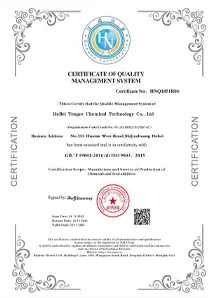
stabilizers and thickeners in food
Stabilizers and Thickeners in Food An Overview
In the realm of food science, stabilizers and thickeners play a crucial role in ensuring that food products maintain their desired texture, consistency, and overall quality. These ingredients are integral to various culinary creations, ranging from sauces and soups to dairy products and desserts. Understanding their functions and applications can help consumers make informed choices about the foods they consume.
What Are Stabilizers and Thickeners?
Stabilizers are substances that help maintain the physical and chemical properties of a product. They prevent the separation of ingredients, ensuring a uniform texture and appearance. Thickeners, on the other hand, are agents that increase the viscosity of a liquid without altering its other properties significantly. While the terms are often used interchangeably, they fulfill distinct roles in food formulation.
Common Types of Stabilizers and Thickeners
There are numerous types of stabilizers and thickeners, each derived from different sources. Some of the most common ones include
1. Gums Natural polysaccharides such as xanthan gum, guar gum, and locust bean gum are widely used for their thickening properties. These gums are often used in salad dressings, gravies, and ice creams to create a desirable mouthfeel.
2. Starches Derived from plants, starches like cornstarch, arrowroot, and potato starch are traditional thickeners in cooking. They gel when heated or mixed with liquid, making them ideal for soups, sauces, and puddings.
stabilizers and thickeners in food

3. Gelatin This protein, derived from animal collagen, is a classic stabilizer in desserts like jellies and mousses. Gelatin creates a gel-like texture, enhancing the stability and mouthfeel of various products.
4. Pectin Found naturally in fruits, pectin is a crucial ingredient for making jams and jellies. It acts as a gelling agent that helps achieve the desired consistency.
5. Carrageenan Extracted from red seaweed, carrageenan is often employed in dairy products such as chocolate milk and cream, where it acts as a thickener and stabilizer, preventing separation.
Applications and Benefits
The inclusion of stabilizers and thickeners in food enhances the sensory experience for consumers. They improve texture, extend shelf life, and can even enhance flavors by providing a better mouthfeel. For manufacturers, these ingredients are essential for ensuring product consistency, which is indispensable for maintaining brand loyalty.
However, it is worth noting that while many stabilizers and thickeners are derived from natural sources, some may be synthetic. Consumers are increasingly aware of the ingredients in their food, prompting a trend towards clean-label products that emphasize transparency and natural formulations.
Conclusion
In summary, stabilizers and thickeners are vital components in the food industry, playing an essential role in the formulation and preservation of various food products. As the food landscape continues to evolve, an understanding of these ingredients will help consumers make better choices that align with their health and dietary preferences.
-
Understanding Synthetic Rubber OptionsNewsApr.27,2025
-
Trichloroisocyanuric Acid: Essential for Clean and Safe WaterNewsApr.27,2025
-
Sodium Dichloroisocyanurate: Key to Safe Water TreatmentNewsApr.27,2025
-
Sodium Acid Pyrophosphate: Essential in Modern Food ProcessingNewsApr.27,2025
-
Essential Water Treatment ChemicalsNewsApr.27,2025
-
Denatured Alcohol and Its Industrial UsesNewsApr.27,2025
-
The Versatile Uses of Sodium BicarbonateNewsApr.24,2025
Hebei Tenger Chemical Technology Co., Ltd. focuses on the chemical industry and is committed to the export service of chemical raw materials.
-

view more DiethanolisopropanolamineIn the ever-growing field of chemical solutions, diethanolisopropanolamine (DEIPA) stands out as a versatile and important compound. Due to its unique chemical structure and properties, DEIPA is of interest to various industries including construction, personal care, and agriculture. -

view more TriisopropanolamineTriisopropanolamine (TIPA) alkanol amine substance, is a kind of alcohol amine compound with amino and alcohol hydroxyl, and because of its molecules contains both amino and hydroxyl. -

view more Tetramethyl Thiuram DisulfideTetramethyl thiuram disulfide, also known as TMTD, is a white to light-yellow powder with a distinct sulfur-like odor. It is soluble in organic solvents such as benzene, acetone, and ethyl acetate, making it highly versatile for use in different formulations. TMTD is known for its excellent vulcanization acceleration properties, which makes it a key ingredient in the production of rubber products. Additionally, it acts as an effective fungicide and bactericide, making it valuable in agricultural applications. Its high purity and stability ensure consistent performance, making it a preferred choice for manufacturers across various industries.











